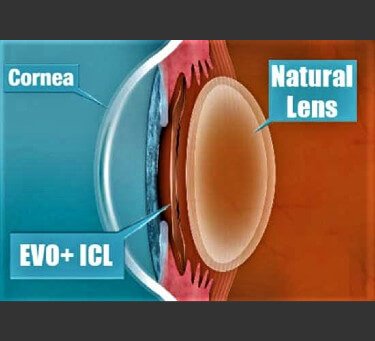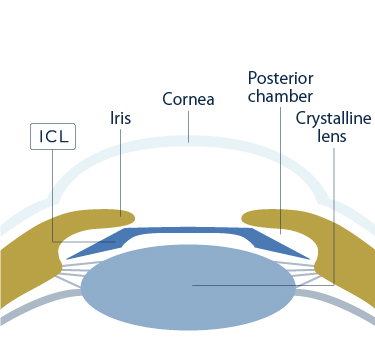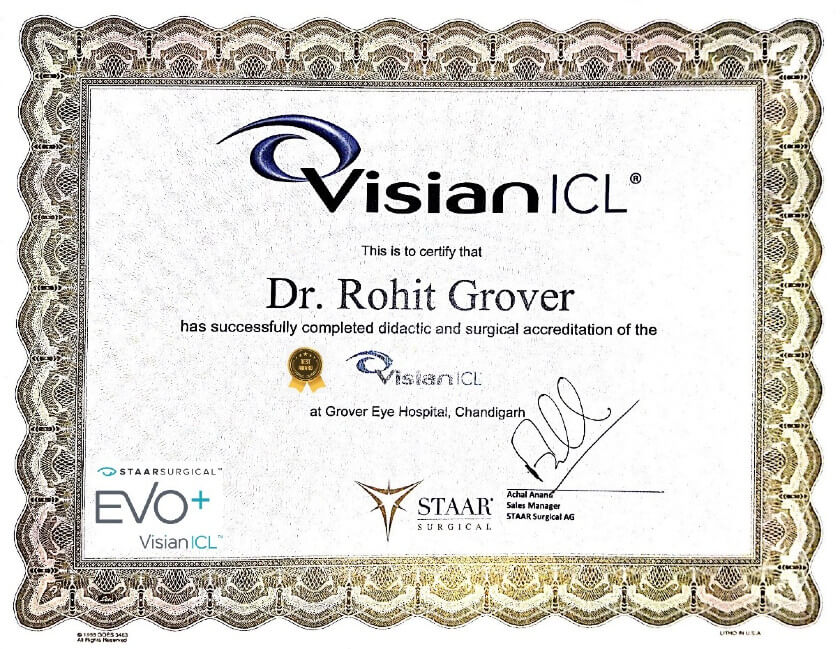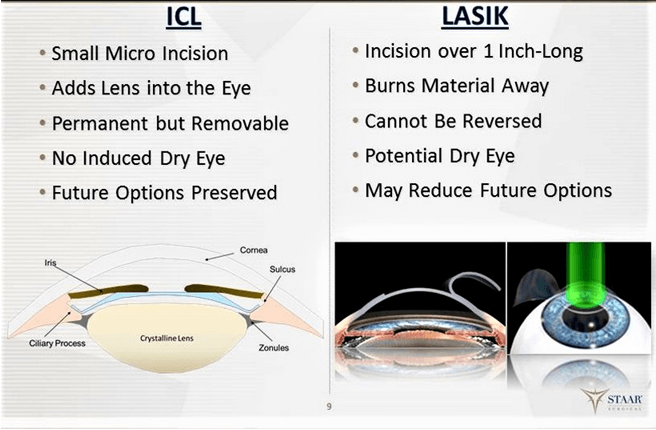Also called phakic intraocular lens (PIOL) is a special kind of intraocular lens that is implanted surgically into the eye to correct glasses numbers.
It is called "phakic" (meaning "having a lens") because the eye's natural lens is left untouched and so it is done in eyes with clear natural lens (not having cataract).

Implantable Collamer Lens



ICL / EyePCL / IPCL (Implantable Phakic Contact Lens) also referred to as Phakic IOL’s are micro thin lens. These are made of soft, biocompatible collagen-polymer or soft hybrid acrylic material to ensure long term performance. These lenses are customized according to shape & size of each eye and are implanted over the natural lens, inside the eye, to correct spectacle power.
LASIK, SMILE, CONTOURA LASER, ASA & ICL are five most popular options available for freedom from glasses.
In CONTOURA VISION / LASIK / SMILE / ASA procedures, lasers are used to correct spectacle power. The procedure involves reshaping the curvature of the cornea so that the light is properly focused at the back of the eye on the retina.
ICL is a US-FDA approved stitchless vision correction procedure with best visual outcome in cases which are not suitable for laser vision correction.
Only if the cornea is too thin even for ASA or pupil are big along with thin cornea then ICL / IPCL or Implantable Phakic Lenses are used.
Laser vision correction like Contoura Vision or ASA is the first choice for glasses removal in most patients. ICL / IPCL lens implants are advised only if somehow laser vision correction is not suitable or such facility is not available.
ICL Implant and Laser Vision Correction, LASIK / ASA may be combined to enhance the accuracy and range of correction, even up to 30 diopters or more or very high cylinder etc. This combination of cornea and lens based procedures is called BIOPTICS.

Dr.Rohit Grover is the only doctor in this region to have received the most coveted ICL accreditation certificate from Staar Surgical, Switzerland.

The advantage of the ICL is that it can permanently correct distant vision. After an ICL implant even for very high powers, 95 percent of the patients do not need glasses or contact lenses. If you are over 40 years old, you may need reading glasses or now Multifocal Phakic lenses / Presbyopia correcting IPCL are also available.

The ICL is inserted into the eye through a small incision

ICL Screening Tests are the most crucial step to a good visual outcome.
Measurement of true AC depth, ICL size and other parameters that must be customized to individual eye are done most meticulously by ICL experts at our hospital.
Accurate spectacle power of the eye ( Refraction), angles of the eye, size of the cornea called as white to white, the curvature of the cornea known as keratometry and the corneal thickness called as Pachymetry are also measured during screening .
The space called true Anterior Chamber Depth (ACD) should be 3.0 mm or more, for an ICL to go within the eye but anything more than 2.75 mm is acceptable for new generation of ICLs.
Retina evaluation is done by our retina specialists to examine the central and peripheral retina. ICL are usually done in high spectacle powers called high myopia. The retina in such eyes can be associated with retina breaks and holes which carry the risk of retinal detachment or various other degenerations. The treatment requires retina photo-coagulation which is done by a painless laser LIO or advanced PASCAL retinal laser available at our hospital.
1. Spherical Implantable CollamerLens , ICL / IPCL / Eye PCL
Spherical ICL lens corrects only spherical power of glasses. Spherical ICL can be used in patients with thin corneas, large pupils, dry eyes, and in high refractive errors all of which are not suitable candidates for LASIK or ASA. They are most commonly used in high power beyond - 8 D in eyes with normal corneas or in eyes with lower power and very thin corneas when Smile, Lasik, Contoura or even ASA is not advisable.
The lens is customized according to shape & size of each eye. ICL surgery provides a safe and effective surgical correction of powers up to -30.0 D and +15.0 D. Custom made IPCL lenses are made to correct even higher powers.

Toric ICL / Toric IPCL lens corrects cylinder along with spherical power of glasses. It can correct up to +15 to -30 D of sphere and up to +/- 10.0 D of cylinder as well .TheToric ICL over time has proven to be an extremely safe and effective option for better vision without glasses. The lens can be custom made according to shape & size of each eye.

TORIC ICL
Multifocal IPCL or Monovision ICL is for distance and presbyopia near vision correction.The PresbyopicToric IPCL offers the widest range customizing to as high as + 15.0 D and -30.0 D with cylinder correction up to 10.0 D and a presbyopic near add of up to +4.0 D.

Multifocal IPCL
Certain patients even without cataract, with very minimal cataract or with Dysfunctional Lens Syndrome (DLS) may be advised a procedure called Laser Lens Replacement (LLR) instead of ICL. This is generally done for some high glasses number patients and it involves replacement of the natural lens inside the eye with a high-performance lens implant.
Clear Lens Extraction (CLE) with Laser Lens Replacement is also known by other terms such as Natural Lens Replacement (NLR), Refractive Lens Exchange (RLE). These procedures are generally more recommended for people with high plus numbers and less frequently for high minus number patients. Even if you need to have Cataract Surgery many years after an ICL or IPCL implant, the correction is as simple as any other cataract surgery.

ICL procedure is safe and also US-FDA approved procedure. Some of the risks which are extremely rare include infection, increased intraocular pressure, and the possibility of accidental damage to the crystalline lens caduring the procedure.
These are another variant of ICL manufactured by leading Indian manufacturers.
These lenses are available only on order. If the power is less complicated the lens can be available as early as 5 days, complicated powers can be implanted after about 2 weeks, even more complicated numbers may take even longer to be available after confirmed order.
The procedure doesn’t cause any pain. After the procedure, for the next three to four hours, there can be some discomfort.
Before the treatment, screening workup is done which includes different types of investigations and calculations and takes about 2 hours. The ICL is imported which takes about 10-12 days. It takes from one to two weeks for full recovery.
Most of the people, approximately 95 percent, will never need glasses again. The remaining 5 percent will have decreased dependence on glasses requiring it for fine work.
If there is a need, doctor will recommend you to use specs or contact lenses.
After ICL treatment, eye behaves like a normal eye. It means that you may require glasses for reading after 40 due to the normal aging process of an eye.
The lens is designed to remain in place permanently; a qualified ophthalmologist can remove or replace the implant, if required.
No. Since the lens is positioned behind the iris (the colored part of the eye), it is invisible to both you and observer in normal circumstances.
It stays in position by itself once it is put in place inside the eye and does not interact with any of the eye’s structures and the patient does not feel it.
One advantage of the ICL is that it is reversible, the ICL can easily be removed and replaced. If necessary, another procedure can be performed at any time. Patients can wear glasses or contact lenses as needed following treatment with the ICL.
ICL surgery is safe and effective for Keratoconus patients whose disease is stable and has stopped progressing and who are unfit for corneal procedures and intolerant to refractive correction by spectacles or contact lenses
Collagen cross-linking (CXL or C3R) is done to slow / halt the progression of Keratoconus. After C3R treatment once the refraction stabilizes, vision is improved with ICL.
Refractive surgery is an elective procedure, and best planned after delivery once the refractive power of the eye has stabilized. Moreover since some oral medicines may be required during or after this surgery, it is not advised during pregnancy.